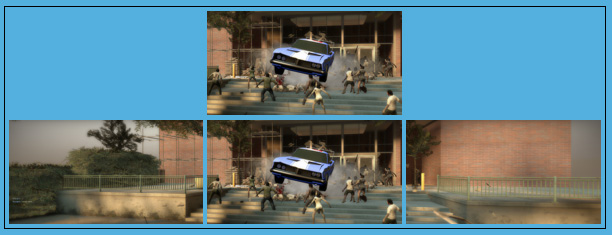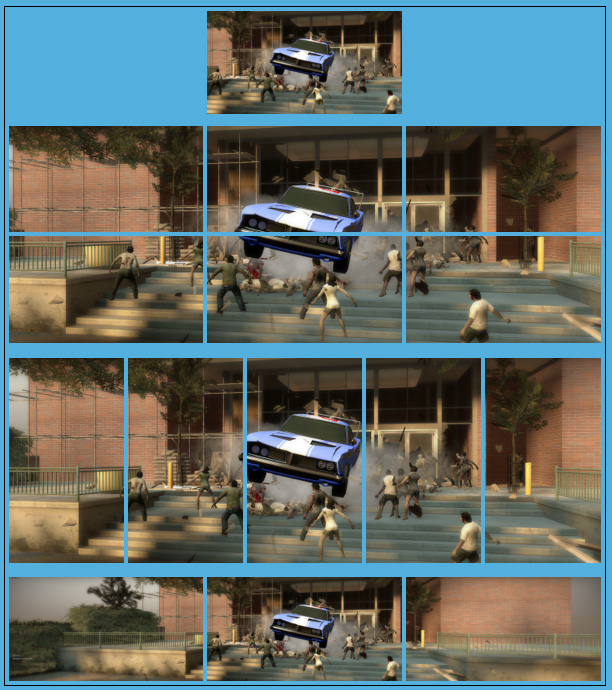ATI Radeon 5870 Eyefinity6 Review - Eyefinity Updated
Eyefinity Updated - Rethinking Immersion
Gamers visiting the WSGF can generally be grouped within two categories: those that are looking for information about gaming on widescreen displays (information we have been pioneering since 2003), and those looking for information about multi-monitor gaming (first introduced in 2006 with the release of the Matrox TripleHead2Go).
Matrox introduced gamers to “Surround Gaming” with the TH2Go, initially offering 3x1 support with 1280x1024 displays. Much discussion has taken place on the WSGF forums about the benefits and drawbacks of gaming across three “square” panels, when compared to a single (and possibly larger) widescreen display. These discussions had a slight change in direction and tone as Matrox released its updates to allow 3x1 support on widescreen displays. But through all of this time, multi-monitor and “Surround Gaming” ideals were confined to panels in a 3x1 landscape configuration. And the primary ideal was greater immersion through an increased aspect ratio and field of vision.
The release of the original HD 5870, and the current release of the HD 5870 Eyefinity6, continue to bring additional definitions of what can be considered “immersive gaming.” We have seen a shift on the WSGF since the release of the HD 5870 and the introduction of Eyefinity. We have seen more interest and dialogue about “traditional” 3x1 gaming, but we have also seen an interest in other variations such as 3x1 in portrait, 5x1 in portrait, 3x2 landscape and other configurations.
Immersion by Aspect Ratio
Traditionally, 3x1 landscape (3x1-L) has offered a clear sense of immersion over a single widescreen display. It is easy to see the increase aspect ratio offered by three displays, and the increased field of vision when a game properly supports that aspect ratio through “Hor+” or “Pixel based” behavior.
The one area lacking in a 3x1-L implementation is the physical height of the monitors. Most gamers end up with 3x22” or 3x24” monitors, which have an average height of 12” - 14”. While the 3x1-L setup extends to the users’ horizontal periphery, the vertical field of vision still includes objects and items other than the monitor.
The below graphic shows the difference in a single widescreen monitor, and a 3x1-L widescreen configuration. Additionally, most of the existing WSGF Surround gameplay videos on YouTube highlight this difference.
While doing a "final pass" review of the article, something struck me about the configuration options. You could set up 5x4:3 20" monitors, each with a resolution of 1600x1200. The horizontal resolution hits exactly 8000 pixels, which is under the "8k" limit. When compared the 5x1-P, the reduced height produces a wider FOV with fewer pixels to push. The trade-off would be a more pronounced edge distortion.

Immersion by Physical Size
Many detractors of Eyefinity gaming would offer a statement such as, “I’d rather just buy a 50” HDTV and game off of that.” Point taken. However, your 50” TV only has a resolution of 1920x1080. And, that TV is probably sitting 12-18 feet away from you across your living room. If said user sat 2-3 feet from said HDTV, they could easily count the 2,073,000 pixels staring at them and be treated to a nice dose of the “screen door” effect.
The 3x1-P option offered by Eyefinity provides 6.2M pixels. And with a 22” monitor size, the three panels (interior bezels included) offer a diagonal of almost 39”. While this is less than the theoretical 50” HDTV mentioned in the statement above, the fact that the user is sitting less than four feet from these monitors means that your physical vision is fully immersed.
The 3x2-L option now available with the E6 card provides 12.4M pixels. Using six 22” monitors, the total panel size (again, including the interior bezels) is right at 56” on the diagonal. This value will vary slightly, depending on the angle between your center and outside monitors.
The 3x1-P mode already available with the original HD 5870 provides an aspect ratio of approximately 16:9.5 - dead in the middle between 16:9 and 16:10. The 3x2-L mode offered by the HD 5870 Eyefinity6 provides an aspect ratio of 16:6 - slightly wider than a normal widescreen aspect ratio.
Below is a table of current and future options (arranged by increased FOV). Using 16:10 monitors would produce slightly different results - such as slightly narrower aspect in 3x2, and slightly wider aspect in 5x1-P.
| 16:9 Monitor Config | Resolution | Aspect Ratio | Normalized Aspect Ratio | Field of Vision | Total Pixels |
| 3x1 Portrait | 3240x1920 | 27:16 | 16:9.5 | 87 | 6.2M |
| Single Widescreen | 1920x1080 | 16:9 | 16:9 | 90 | 2.1M |
| 3x2 Landscape | 5760x2160 | 16:6 | 16:6 | 113 | 12.4M |
| 5x1 Portrait | 5400x1920 | 45:16 | 16:5.7 | 115 | 10.4M |
| 3x1 Landscape | 5760x1080 | 16:3 | 16:3 | 143 | 6.2M |
| 5 x 4:3 (1600x1200) | 8000x1200 | 20:3 | 16:2.4 | 150 | 9.6M |
| 5x1 Landscale (1600x900) | 8000x900 | 80:9 | 16:1.8 | 157 | 7.2M |
Balancing Aspect & Physical Size
ATI once again teases us with a future feature, in the form of 5x1-P. Windows itself handles 5x1-P with an extended Windows desktop (so productivity is covered), however Eyefinity can only group three displays into a portrait configuration. Physically, five monitors in portrait mode is right at the same width as three panels in landscape. Thus, your horizontal peripheral vision is filled. The portrait configuration also ensures that the vertical peripheral vision is filled as well.
I didn’t think I would be a fan of the portrait configuration, and was surprised to find that 3x1-P was Kyle Bennet’s (of HardOCP) preferred setup with the original HD 5870. I have five panels in portrait configuration, and since I’ve been benchmarking the 3x1-P configuration I can see why Kyle preferred this option. Though it isn’t to everyone’s taste, it does have its benefits.
Below is a comparison of the same scene as viewed through different Eyefinity options.

While less than the traditional 3x1-L aspect (of approximately 16:3.2), the 5x1-P implementation of 16:5.5 offers obvious enhancements over 16:9 or 16:10. Personally, I see 5x1-P as the perfect balance for physical and aspect immersion, for the following reasons:
- Physically fills the field of vision - both horizontally and vertically.
- It offers a significantly increased aspect ratio over “normal” widescreen
- Due to a less “extreme” aspect ratio, it would suffer less “edge distortion” than 3x1-L.
- Doesn't have the horizontal bezels of 3x2 Eyefinity
- If a game doesn’t support ultra-wide aspect ratios, you could still play in “widescreen” on 3x1-P, at an ultra-high resolution (rather than a single small widescreen).
- Games that “break” in ultra-wide aspect ratios (i.e., disappearing objects in Dragon Age: Origins, broken cinematics in The Witcher, etc.) may function normally in a less extreme aspect ratio.
The images and data for the table were pulled using the new WSGF FOV and Aspect Ratio Calculator created by forum member Delphium. The tool is a great update to our original FOV tool, and provides a wealth of information. Thanks for all of his hard work on this excellent tool.
